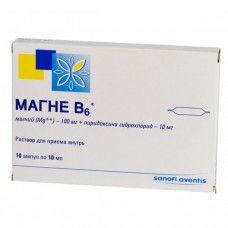Expiration date: 04/2025
The composition and form of issue:
Magne B6
Tablets, film-coated. 1 tablet contains active substances:
magnesium lactate dihydrate 470 mg
(corresponds to 48 mg of magnesium (Mg2+)
pyridoxine hydrochloride 5 mg
excipients: sucrose, heavy kaolin acacia gum carboxypolymethylene 934 talc (magnesium silicate hydrate) magnesium stearate
the shell of the tablet: gum acacia sucrose titanium dioxide talc (magnesium silicate hydrate) Carnauba wax (powder)
blistere in 10 PCs., in a cardboard bundle 5 blisters.
The oral solution 1 amp. (10 ml) contains active substances:
magnesium lactate dihydrate 186 mg
magnesium pidolate 936 mg
(corresponds to 100 mg of the total content of magnesium (Mg2+)
pyridoxine hydrochloride 10 mg
auxiliary substances: sodium disulfit sodium saccharin cherry flavor-caramel purified water to 10 ml
in dark glass ampoules of 10 ml in cartons of 10 vials.
Magne B6 forte
Tablets, film-coated. 1 tablet contains active substances:
magnesium citrate 618, 43 mg
(corresponds to 100 mg of magnesium (Mg2+)
pyridoxine hydrochloride 10 mg
excipients: lactose macrogol 6000 magnesium stearate hypromellose 6 MPa.with titanium dioxide (E171) talc
blistere in 15 PCs. in cardboard pack 2, or 4 blisters.
Description pharmaceutical form:
Magne B6
The coated tablets: oval biconvex, white color, with a smooth shiny surface.
The solution for the reception inside: transparent brown liquid with a smell of caramel.
Magne B6 forte
Tablets, film-coated oval biconvex, white. On a break you can see two layers: the shell is white and tablet white mass.
Pharmacological action:
The drug, complementary deficit magnesium.
Pharmacokinetics:
Gastrointestinal absorption of magnesium salts takes place partly by the passive mechanism in which the solubility of salt plays a crucial role. The degree of absorption does not exceed 50%. Excretion occurs mainly by the kidneys.
Description pharmacological action:
Magnesium is a vital element necessary for the normal functioning of cells, involved in most metabolic reactions.
In particular, he is involved in the regulation of transmission of nerve impulses and in muscle contraction. 1/3 the amount of magnesium contained in the body, collects in bone tissue. The body gets magnesium from food. The lack of magnesium in the body may be in violation of the diet (diet) or by increasing the need for magnesium.
Pyridoxine (vitamin B6) participates in many metabolic processes, improves absorption of magnesium from the gastrointestinal tract and its penetration into cells.
The levels of magnesium in the serum:
between 12 and 17 mg/l (1-1, 4 mEq/l or 0, 5-0, 7 mmol/l) indicates moderate magnesium deficiency
- below 12 mg/l (1 mEq/l or 0, 5 mmol/l) indicates severe magnesium deficiency.
Indications:
Established magnesium deficiency, isolated or associated with other deficiency States, accompanied by symptoms such as: irritability, minor sleep disturbances, gastrointestinal spasms, heart palpitations, fatigue, pain and muscle spasms, tingling sensation in the muscles.
If after a month of treatment, no reduction in these symptoms, continuation of treatment is inappropriate.
Contraindications:
- hypersensitivity to the drug
- expressed kidney failure (Cl creatinine <30 ml/min)
- phenylketonuria
- children up to age 6 years (for tablet dosage forms) and 1 year (for a solution)
- intolerance to fructose, syndrome of impaired absorption of glucose and galactose or a deficit sucrase-isomaltase (Magne B6)
- hereditary galactosemia, malabsorption syndrome of glucose and galactose or lactase deficiency (due to presence in the product is lactose) (Magne B6 Forte)
- simultaneous treatment with levodopa (see section "Interactions").
Caution: moderate insufficiency of the kidney (the risk of gipermagniemii).
Application of pregnancy and breast-feeding:
During pregnancy can be used only on the advice of a doctor.
Magnesium passes into breast milk. Avoid the use of the drug in lactation and breastfeeding.
Side effects:
Allergic reactions, including skin disorders of the digestive tract: diarrhea, abdominal pain, constipation, nausea, vomiting, flatulence.
Drug interactions:
Contraindicated in combination
Levodopa: levodopa activity (if the drug is not combined with inhibitors of peripheral DOPA-decarboxylase) is inhibited by pyridoxine. You should avoid any intake of pyridoxine, if the levodopa is not assigned to a peripheral inhibitors of DOPA-decarboxylase.
Deprecated combination
Simultaneous use of preparations containing phosphates or calcium salts, can greatly reduce magnesium absorption in the gastrointestinal tract.
With phosphate or calcium salts: these products inhibit the intestinal absorption of magnesium.
Combinations to be taken into account
In appointing the interior of tetracycline is necessary to observe an interval of at least 3 h between ingestion of tetracycline and magnesium, because magnesium reduces the gastrointestinal absorption of tetracyclines.
Magnesium reduces the effect of oral thrombolytic funds reduces the absorption of iron.
Method of application and dose:
Magne B6
Inside. Before receiving the drug you should consult with your doctor.
The coated tablets: for adults, take 6-8 tab./day children over 6 years (body weight more than 20 kg) table 4-6./day.
The daily dose should be divided into 2-3 doses, take with meals with a large glass of water
The oral solution: adults take 3-4 capsules a day children over 1 year of age (weighing more than 10 kg), a daily dose of 10-30 mg/kg and equal to 1-4 vials.
Solution in ampoules diluted in 1/2 Cup water for the reception 2-3 times a day during meals.
The average duration of treatment is 1 month.
Treatment should be discontinued immediately after the normalization of magnesium levels in the blood.
Attention! Samoudlinyayuschiesya vials of Magne B6 does not require the use of a nail file. To open the vial, you need to take her for the tip, previously covered it with a piece of cloth, and break it off with a flick.
Magne B6 forte
Inside. Tablets should be taken whole with a glass of water. Adults: 3-4 table. per day, divided into 2-3 reception during the meal.
Children under the age of 6 years (weighing about 20 kg): 10-30 mg/kg/day (0, 4-1, 2 mmol/kg/day), i.e. children over 6 years (weighing about 20 kg) table 2-4. per day, divided into 2-3 reception during the meal.
Typically, the duration of treatment is 1 month.
Overdose:
With normal renal function overdose of magnesium ingestion usually does not cause toxic reactions. However, in the case of renal insufficiency may develop toxicity to magnesium.
Overdose symptoms (the severity depends on the concentration of magnesium in the blood): decrease in blood pressure, nausea, vomiting, CNS depression, decreased reflexes, ECG changes (ischemia and/or arrhythmias), respiratory depression, coma, cardiac arrest and respiratory paralysis, anuria.
Treatment: rehydration, forced diuresis. In renal failure required hemodialysis or peritoneal dialysis.
Special instructions:
Drug dosage form tablets is for adults only and children over the age of 6 years. For younger children it is recommended that the drug in the form of a solution for intake.
When moderate renal insufficiency should take the drug with caution because of the risk of gipermagniemii.
In case of simultaneous deficiency of calcium and magnesium magnesium deficiency should be remedied before the start of the supplementation of calcium.
In the application of pyridoxine at high doses for a long time (over several months or in some cases years) can develop a sensory neuropathy that is accompanied by symptoms such as numbness and vestibular disorders, tremor of the distal extremities and gradually developing sensory ataxia (loss of coordination). These disorders are usually reversible and disappear after the cancellation of high doses of vitamin B6.
Patients with diabetes should be borne in mind that tablets coated (Magne B6), contain sucrose as excipients.
Frequent use of laxatives, alcohol, intense physical and mental stress need for magnesium increases, which can lead to the development of magnesium deficiency in the body.
The vials do contain sulfite, which can cause or worsen reactions allergic-type, including anaphylactic reactions, in patients at risk.
Effects on ability to drive and other mechanisms
Specific recommendations no.




